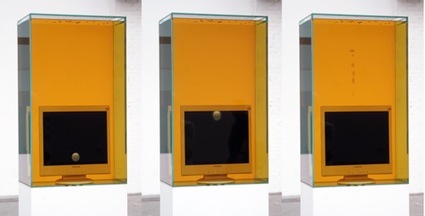 Image by Marc Wathieu
Image by Marc Wathieu
Vincent Evrard recently graduated from the Ecole de Recherche Graphique in Brussels with a thesis that explored the relationship between men, the clouds and the internet. One of the outcomes of his investigation is Aphrogenea, an installation that plunges a computer into a bath of sterile oil. The computer does survive the ordeal. It breathes bubbles that slowly rise from the bottom of its screen. Once it has reached the top of the screen, the virtual bubble becomes an air bubble that rises through the oil to the surface of the tank where it vanishes into thin air.
For this second “Showcase” (an exhibition format for emergent artists), the iMAL center in Brussels has invited Vincent Evrard to present Aphrogenea and since i’m not sure i can make it to Brussels to see the work i thought i’d catch up with the artist and have him talk about his work:
The intro text to your work says that it was “born from a thesis Fixer les nuages which proposes a genealogy of clouds leading to the advent of the Internet.’ Can you gives us more detail about this?
The ambition of “Fixer les nuages” is to approach, to observe the relationship that men have with clouds. This observation starts with an image (see below) that represents the path that information takes before and after it has come our way. I was curious about what this diagram tells us about the path taken by information and more precisely, about this particular point in the diagram where our connection turns into a cloud called “Internet.” This observation allowed me to develop the idea of a new definition of internet through the cloud.
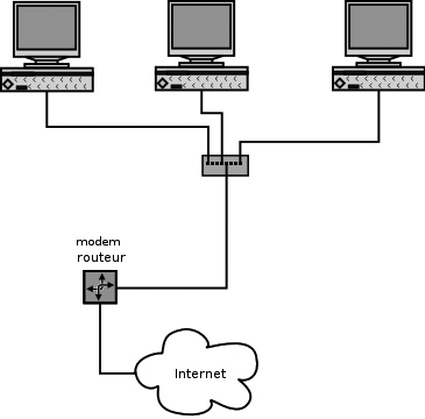
You can find more about my research on the website http://fixerlesnuages.tumblr.com/. That’s where i collected a series of elements that relate more or less closely to the links between human/cloud/internet and my thesis is available online in PDF.
In order to illustrate this part of the reflection, i undertook to create a sculpture that would make something from this cloud/internet more tangible. That’s how it all started. I had to immerse a computer in an environment that would allow the cloud/internet to emerge from the computer and finally exit through the screen. The bubbles that we see escape from the screen are something that come from the internet.
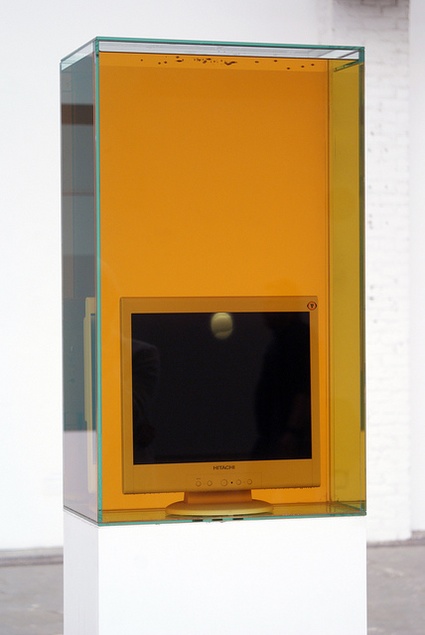 Image by Marc Wathieu
Image by Marc Wathieu
How did you get from clouds to oil?
I use oil to create a medium that allow viewers to see the passage that the bubble of cloud/internet has to take before it can reach the physical world.
I have a confession to make, when i sent you the email asking you for an interview i had not read about the bubble. I was just mesmerized by the sculptural presence of Aphrogenea and the boldness of throwing a computer inside liquid. Can you explain us how you chose to make the work look like this big luminous, graphic and solid-colored sculpture on a high pedestal?
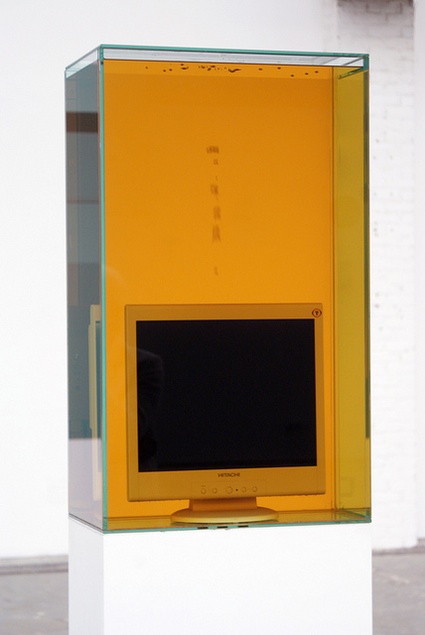 Image by Marc Wathieu
Image by Marc Wathieu
Apart from the technical constraints that contributed to shaping Aphrogenea as we see it now, i thought it was essential to make a vertical sculpture. A vertical direction underlines the path taken from the bottom to the top: from the invisible to the invisible and then to the vanishing. My work consisted in making visible this itinerary.
Which type of oil are you using in this installation and what are its properties?
I use a mineral oil. It is more commonly found inside fridge engines. The characteristic of this oil is that it is electrically insulating. It also has a very specific heat capacity, a property which enables it to capture the heat produced by the screen and create a movement akin to an aura rising from the screen to the surface of the oil.
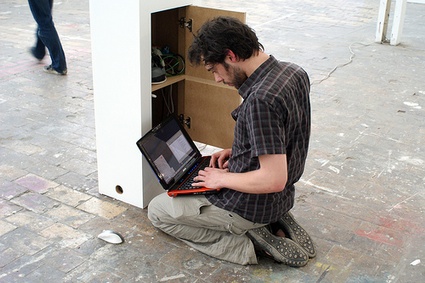 Image Marc Wathieu
Image Marc Wathieu
Now can you get a bit techy and explain us how the installation works? How can the bubble go through these transformations?
A pc running a processing applet is hidden inside the basement. The applet controls the screen display in the tank. When a virtual bubble approaches the upper border of the screen, the applet sends a command to an Arduino which turns on a air pump. The air pump switches off so quickly that only one bubble exits the screen. The connections between the tank and the inside of the base are limited to a vga cable, power supply and an air hose. They go through the base of the screen and cross the glass panel. The air hose rises through the whole screen and ends up at the top, between the two electronic elements where it blows the bubbles.
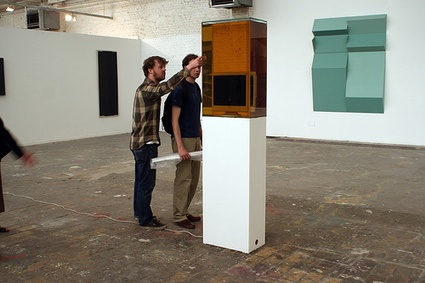 Image Marc Watthieu
Image Marc Watthieu
What was the biggest (technical or not) challenge you had to face when developing this work?
I presented this work for my jury evaluation at the ERG in June 2010. It turned out that the first time i managed to assemble the piece was precisely the day before the jury only because i didn’t have a base before. Without the base, i could not fill in the tank to test whether it was perfectly sealed, nor could i plunge the screen inside the oil. I was running the risk of facing a leak or a fried screen on the day of the jury. However, i felt confident. I had spent the previous week immersing electronic material (webcam,…) and 220v electrical material inside the oil and everything worked just fine before, during and after the immersion. The main challenge was the whole organization. And getting my hands on 120 litres of oil. The company L’ atelier du froid took a leap of faith and gave me the oil for free.
Any upcoming project? Exhibition? Ambition?
Right now, i’m mostly trying to exhibit Aphrogenea. I’m also looking for funding for my next installation. That one will also stem from the relationship man/cloud/internet.
Merci Vincent!
Aphrogenea is on view at iMAL in Brussels from 8 February until 11 March 2011.
